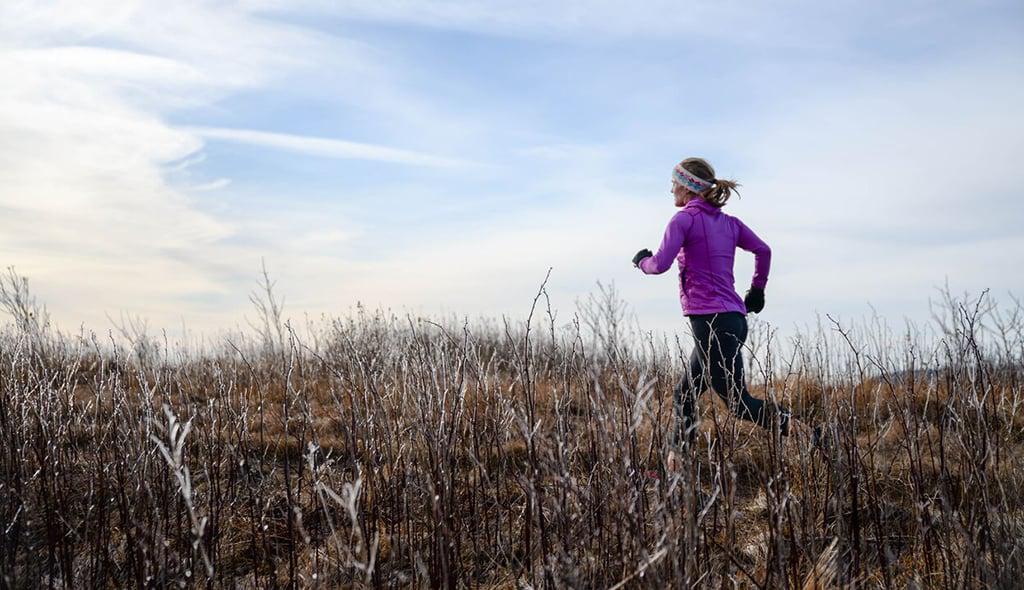 Photo Credit: Melina Coogan[/caption] Let’s play a game of Would You Rather: Would you rather jog beside exhaust-spitting traffic, growing stiff while waiting for walk signs and feeling the density of pavement with each step, or weave through the forest on single-track trail, the ground spongy and varied, the stillness interrupted only by the chirping of birds or a gust of wind? That’s what we thought. According to the 2013 Outdoor Participation Report, more first-time runners found themselves on trails than roads in 2012. The number of trail runners grew from 4.5 million to more than 6 million in the United States between 2006 and 2012. Trail running is experiencing a surge in popularity, with converts from road running and triathlons, mountain climbing, the gym — no matter what your background, you can be a trail runner. Here's what we love about taking running off the beaten track:
Photo Credit: Melina Coogan[/caption] Let’s play a game of Would You Rather: Would you rather jog beside exhaust-spitting traffic, growing stiff while waiting for walk signs and feeling the density of pavement with each step, or weave through the forest on single-track trail, the ground spongy and varied, the stillness interrupted only by the chirping of birds or a gust of wind? That’s what we thought. According to the 2013 Outdoor Participation Report, more first-time runners found themselves on trails than roads in 2012. The number of trail runners grew from 4.5 million to more than 6 million in the United States between 2006 and 2012. Trail running is experiencing a surge in popularity, with converts from road running and triathlons, mountain climbing, the gym — no matter what your background, you can be a trail runner. Here's what we love about taking running off the beaten track:
- Trail running is a simple and easy-to-access activity and exercise — all you need is a trail and the right pair of running shoes.
- Running on soft, varying surfaces reduces the risk of overuse injuries a great deal, and lends itself to quicker recovery. Additionally, responding to roots and rocks strengthens core muscles and trains mental focus.
- Getting out of the city and into nature, no matter how close to or far from concrete and noise you may be, will calm the mind and body and provide a healthy “time out” from business and hustle.
- Why dream of running laps around the track when you could train for journeys through canyons and along mountain ridgelines?
So there’s the why, now time for the how. Below we’ll break down all you need to know to get started on the trail.
Trail running gear
Running is consistently the most practiced sport in the US, in large part due to the fact that it requires very little gear to get started. Trail running is no different. The less gear the better, as it will just weigh you down. Here are the essentials:
- Shoes: Your road running shoes will suffice for the first few outings on a trail; however, just as mountain bike tires provide a better experience on trails than road bike tires, so trail running shoes are better suited toward trails than their road counterparts. Trail running-specific shoes offer a more protective sole, rock-gripping tread, greater stability, and oftentimes sport a waterproof upper.
- Clothing: Although an entire paycheck could be dropped on running-specific clothing, any layers that are comfortable and trim fitting, lightweight, moisture-wicking, and breathable will do. For trail running, I especially recommend dressing in layers, with an outer layer light enough to stuff in a pack or tie around your waist. If you are sensitive to the sun, a visor provides great coverage, as does a long-sleeve, light-colored shirt.
- Water: Every runner has a different theory on water consumption and a corresponding method for carrying (or not carrying) their water. If you’re heading out on the trail for over an hour, consider bringing a liter or more of water in a running-specific backpack or vest, a waist belt hydration system, or a handheld water bottle.
Safety tips
The differences between trail and road running stand out when it comes to safety, in the same way that climbing outside necessitates far more precautions than climbing in a gym. You won’t be able to access water, shelter, or help at any point as you could on the street. Weather can move in more quickly in mountainous areas. To compound these issues, you’ll likely be in an area where your cell phone doesn’t work. Here are a few safety items to have on your radar when you set out on a trail run:
- When running a trail for the first time, bring a map. We recommend using Trail Run Project on your phone — download your local trails to be used when your phone is offline. Make sure your wifi is turned on so your phone can still function as a GPS device; you can then track your progress and whereabouts on the app.
- When possible, run with a friend; at the least, make sure to tell someone where you’re headed if it is remote and if you suspect cell service will be unlikely.
- Carry extra food, water, and a headlamp if you’re headed into a new area; carry an extra layer unless you absolutely know not to expect foul weather.
- Be aware of slippery rocks and roots, and stay constantly attentive to the contours and obstacles of the trail as you run.
Finding your trail
Regardless of where you live in the world — urban, rural, or in between — trails are likely just a short drive away. New Yorkers can enjoy the trails of Central or Prospect Parks, while those who live in Colorado can often access trails to the summit of 14ers from just down the road. Of course these experiences will have vast differences, but the ethos of trail running is universal: get away from pavement and crowds, closer to nature, and enjoy a softer, more varied surface under foot. There are many ways to find trails near you, including local running stores, in city, state, or national parks closeby, by leafing through trail running or hiking guidebooks, and of course, Google. My favorite way to locate trails is using the Trail Run Project app on my computer or phone. This app is an offshoot of Hiking Project, a database of over 100,000 miles of hiking trails across the U.S. and internationally. The Trail Run Project lists these trails, specifies those which their users have used as running routes, and displays comments and a quality rating — by and for trail runners — for each.
Advice for beginner trail runners
- Don’t be afraid to walk: On a trail, you’ll encounter hills far steeper and terrain far more technical than on the road. It is a common trail running technique — even among the most seasoned trail runners—to walk briskly through these sections.
- Forget about your pace per mile: Whereas road running can be heavily speed- and statistics-oriented, trail running is far more about the route, the terrain, the views, and the experience. Your pace per mile may be almost twice as long as on the road, though you may feel like you’re working just as hard, if not harder. Because of this, when planning your outings, know to budget more time for your chosen route.
- Find a local trail running group: Get in touch with your local running store, or perhaps check out Facebook or Meetup to meet other local trail runners. This way, you’ll be introduced to the local trail systems, learn layering and nutrition techniques, and stay motivated to run.
- Sign up for a race: The American Trail Running Association (ATRA) has a comprehensive list on their website of trail runs around the country. Signing up for a race can be a great way to provide motivation to train, and also will connect you with other runners in your local community.
Trail running technique
- Use a short stride: Obstacles abound on the trail and you’ll want to keep your feet underneath you to maintain balance. When the trail steepens, shorten your stride even more — both on the downhill and the uphill — for more efficient movement.
- Scan the trail ahead: Trail running is great moving meditation — on technical terrain, you want to constantly be scanning the trail 10-15 feet in front of you, and letting your body respond accordingly. Oftentimes while running, I realize that I’ve been so “in the zone” that I haven’t been thinking about anything but the few steps ahead of me!
- Choose your line: Once I was running with a professional trail runner, and as he watched me run through a section, he remarked, “Nice line.” When obstacles lie ahead, make a game out of choosing the most efficient line, one that allows you to keep your stride and stay sure-footed.
- Use your arms: Swing your arms a bit wider for added balance on more technical trails — along with your core, your arms contribute greatly to your body’s balance.
- Keep your back straight: On the uphill, it’s tempting to lean into the slope over your knees with a hunched back. This, however, reduces our ability to breathe effectively, and might result in side cramps. Stay upright with a tight core.
Trail etiquette
One of the best things about trail running is the freedom: very little gear is needed and it’s simply one’s body moving over the trail. Though, unlike many sports, there are no rules, and no one is on the trails policing your actions, there are a few guidelines that trail runners should adhere to for the good of the community. Here they are:
- Know the rules of the trail: Usually, bikers and hikers will yield to runners, but runners should always be willing to yield to faster-moving individuals, whether on or off wheels, and horses. If you come up behind a slower hiker or runner, be sure to calmly alert him or her to your presence by saying “Hey,” or a direction such as “On your left!" Additionally, runners moving downhill should yield to those running uphill.
- Leave no trace: As with any wilderness activity, we should strive to leave the outdoors as we found it (leave only footprints, take only photographs). This includes packing out garbage, including banana peels, apple cores, and toilet paper. If you need to use the bathroom, do so over 200 feet from the trail and any water source, and dig a hole at least 6 inches deep.
- Stay on marked trails: This guideline is not only for the preservation of the wilderness, but for your safety! Run through puddles — not around them — as this leads to erosion and trail widening.
You have all the information you need, now get out and run! Happy trails.





